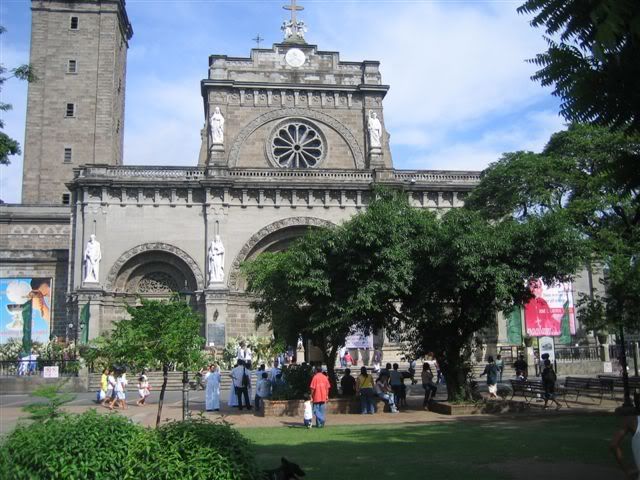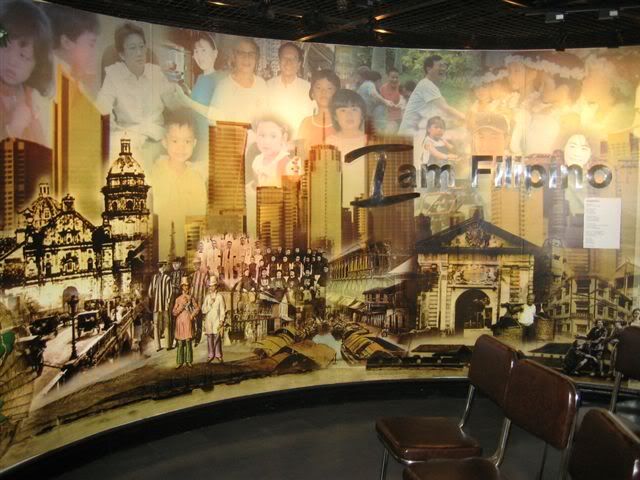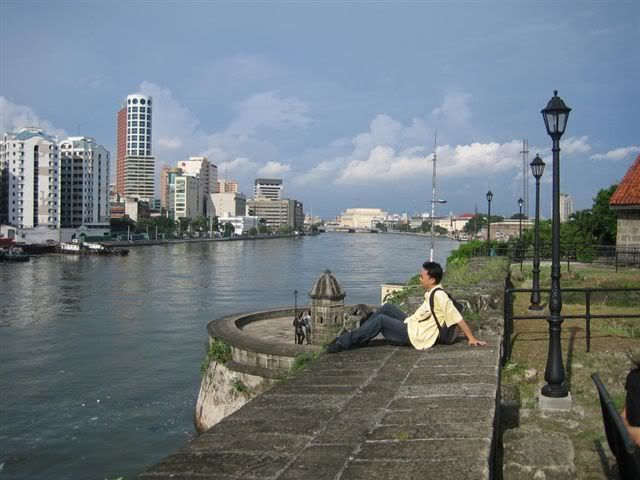Manila, My Manila!
(I wish this appeared during the 400+th (?) anniversary of Manila.)
A visit to Cardinal Sin’s wake last Saturday afternoon (Jun. 24, 2005, 2-3 PM) turned out to be an unintentional rumination on my ethnicity, my complex, multi-layered, confusing, proud, sad, and ambivalent identity as a Filipino. This is something which has always bothered and fascinated me at the same time for its, to be redundant about it, highly nuanced and conflicting nature that even sociologists are hard-pressed to define and explain.
I came with an equally crazy old friend, T2B, who came prepared, armed to the teeth with a digicam, a backpack, and a little guidebook (Manahan’s Street-Bound: Manila on Foot). We met at where else but SM Manila. From there, we took a taxi to the Manila Cathedral, still an elegant-looking landmark, and lost no time making the fifty-meter or so beeline to the bishop’s body lying in state inside the cathedral. I bumped into the bulky-built cardinal only once when he was still alive; he was about to say Mass in the UST chapel, and I think I was about to confess ten mortal sins. He was wearing a golden robe then, exquisitely embroidered, I think. Now, he was inside a coffin in the same priestly garb. (Sidebar: A few paces before us was this journalist Bernadette Sembrano.)
The face of Sin, which looked literally at peace, was also unquestionably Chinese. That fact gave me a weird feeling. I know that that unsettling feeling, the feeling of Filipino-ness, would set the tone for the rest of our trip.
**
That this was Intramuros was, of course, not lost on us, too. We took the chance to drop by San Agustin Church, but it was closed. Nevertheless, Sin’s being half-Chinese manifested itself anew as we stumbled into these puzzling, monstrous-looking fixtures they call fu dogs - mythical Chinese dogs, maybe - guarding the courtyard and the massive door of the church, a "Chinese version of the gargoyles."
We would learn later on that there’s more of the Chinese in this significant Spanish colonial structure than met the eye, but that’s already getting ahead of the story. The main thing at the moment was, this was Intramuros and we should be unavoidably reminded of our Spanish heritage, that being Filipino means being Hispanic in a lot of things.
I remember somebody who had pointed out that, before the Katipuneros became ‘rebels,’ our being a bit Spaniards was more of a choice than an oppression. I was too stumped to hear that that I couldn't react. I was personally reminded of the truthfulness of that as I did this tour: We got willingly converted at the outset. We embraced Catholic Christianity and we were, are, eternally grateful for it. King Philip’s minions certainly did their colonization for more jingoistic purposes, but they also brought in here some of their men of faith whose mission was to evangelize, to spread the faith. It must also be pointed out that we had embraced that faith without a sense of a nation yet but as different tribes or 'peoples.' Soon, we began to fold up the welcome mat and we learned to resent the Spaniards as they tried to rule over us. Our colonizers and their superiority complex started to show and they started to push their weight around in both secular and religious lives, ‘dutifully’ treating us not as their newly evangelized brethren and sistrons but as their inferiors, their ‘uncultured’ subjects unlearning our pagan ways.
Pretty soon, loyalty, fealty, gave way to the Katipunan, the La Liga Filipina, Jose Rizal’s newfound ideas, and culminated into the Cry of Balintawak and the Philippine Revolution (Rebellion to the Spaniards) of 1896.
Nevertheless, it cannot be denied that the Spaniards gave us the Christian faith and a lot more besides, an entire 14th-17th century lifestyle and civilization, which incidentally, included things Mexican because of the Acapulco trade.
Weirdly again, my friend and I saw it fit to move on to things non-Hispanic, to Teresita Ang-See and the KAISA Foundation’s Bahay Tsinoy. But, along the way, we made it a point to stop by the ‘plazuela’ with the sad ‘Memorare’ sculpture, to pay our respects to the 100,000+ innocents who perished in World War II in the hands of the Japanese.
At the Memorare, I saw no ghosts, not that I wanted to see any, but I had this earth-shaking thought to myself: The Filipino is certainly, ostensibly, decidedly, NOT part-Japanese. (Maybe some, but that's not their fault.)
I tried to read from the guide book, but all we got was get all the more confused: “You will see Baluartillo de Santa this, then you will see Baluartillo de Santa that.” I was expecting a PowerPoint presentation, in bullet points! Corporate brat.
At the Bahay Tsinoy (P100, entrance fee), T2B and I got reminded of our Chinese-ness, this time, in our face, in our indubitably Malay face (which should make us, by all means, Malaysians or… Mongols.). Here are our findings: The first Filipino, Jose Rizal, was part-Chinese. The first Philippine president (Duh! Aguinaldo!) was half?-Chinese. The Trece Martirez and Fathers Gomez, Burgos, and Zamora, of the famous acronym Gomburza, were Chinese mestizos. Cardinal Sin was half-Chinese. (The first Manila archbishop, O’Doherty, was an Irish.) The first woman president, Cory Aquino, is a Chinese mestiza. Rats!, even the first official Philippine saint, Lorenzo Ruiz, had some (or a lot of) drops of Chinese blood! (And he was needlessly martyred by the Japanese!)
Going back to the subject of San Agustin church, we were informed in this museum that the lacework on the wooden (tindalo?) door of that church and its choir loft seats are Chinese, not Spanish, and that we should not be surprised to trace a dragon or two, or see a stylized cloud, a phoenix maybe, lotus flowers, or chrysanthemums, in the carving. I bet that even if you didn't care a whit about sculpture, these tidbits of infos sure were i-n-t-e-r-e-s-t-i-n-g.
What's more, it shouldn’t surprise you at all if you learned that you have Chinese blood, too (who knows?), that if you traced your genealogy, you might end up with a pair of chopsticks, that you would be disparaging the Chinese at your own expense, so be careful!
From that time on, I have solemnly decided for myself that I am one-third Intsik. To be Filipino is to be part-Chinese, sure.
But even that one would be an understatement. We, a pair of nosey pseudo-anthropologists, examined the other museum pieces closely, moving at a snail’s pace in the midst of all those obstreperously noisy pharmacy students, who came in their school uniform; their visit was apparently an assignment in class. What T2B and I would find out was the Chinese-ness not just of our blood but our own whole lifestyle as a people – from food (siopao, lumpia) to play (sungka, kite, even top?), to embroidery, to business (sari-sari store), to publication (the Chinese woodblock technology was used to publish en masse the first Philippine book, the Doctrina Christiana), to advanced pottery (which we never absorbed fully), to a lot of other things. Every Filipino should visit Bahay Tsinoy if only to realize all these, to realize that a lot of things we thought to be 'authentic Filipino' are actually authentic Chinese.
The Kaisa Group, an anti-crime, anti-violence group, however, pointedly omitted the Chinese contribution of gunpowder and firecrackers (paputok). (I don’t see anything wrong with defending the state for national security and celebrating New Year’s Eve.) And they snubbed, too, Dolphy’s big-time contribution to local show biz entertainment, with a blatant non-inclusion in the roster of honorable and role-model Fil-Chinese! (I love to moralize, I know that, but I think Dolphy should not be snubbed because he was a significant pioneer.)
**
What would our next stop be in our itinerary but Fort Santiago (Entrance fee, Php40), whose renovation job during the Centennial was dubbed a “darkness” and a “museum of hate” by Dr. Fernando Zialcita, et al. I remember siding with them academics, of course, because theirs was the more sober, not to mention informed, assessment of history.
As we went there, we tried to avoid crossing certain side streets that looked like they never recovered from World War II. (My chronic complaint about the living museum that is the City of Manila is the fetid smell of some of its nooks and crannies (centuries of men taking a leak, sure), the grime, the dust, plus the innumerable black spots left by trampled-upon chewing gum on the tiles of the LRT and other centuries-old walkways. A huge, huge turnoff!) Anyway...
Age-old questions cropped up in my mind as we ambled around what we'd find to be a modernized, well-manicured "museum of hate" every Filipino can be… proud of (?). Where was Carlos Celdran, the walk tour guy, when we needed him most? Did Rizal retract? The Jesuits say yes and claim they have evidence. Historian Manuel L. Quezon III believes so, too, but qualifies that Rizal did so because he felt being forced to do it given the circumstances anyway, and perhaps just to please the priests, too, so in essence, in classic Galilean fashion, Dr. JPR didn’t retract. Dean Jorge Bocobo and the Masons, of course, insist that Rizal most assuredly did not.
I not-so-humbly insist that we'll never know what could exactly be on Rizal's mind during his dying moments, so case closed.
(Sidebar: I personally believe Rizal is not just a secular saint. He could actually be a Christian saint; what he fought for was a moral fight and his martyrdom was the one that's immoral. Martyrs, to go by ancient beliefs, go straight to heaven, all their other sins forgiven. Besides, I don’t think heaven allows any man to be eternally honored like Rizal if he’s in hell right now, right?!? I don’t know. Maybe the Jesuit fathers should douse me with cold holy water?)
What would we find milling about the Rizal Shrine (formerly called Fort Santiago) but every imaginable ‘race’ visiting -- tourists galore! We just couldn’t avoid the question of identity then, our feet aching notwithstanding. (Incidentally, Carlos Celdran had temporarily cancelled his allegedly gossipy and thus entertaining historical/architectural walk tour operations, so we had to tour-guide ourselves armed with a knowledge that’s dangerously close to zero. It turned out the danged guidebook we brought was meant to be read beforehand! But, oh, I had read Nick Joaquin’s “Manila, My Manila,” so I had a little historical chismis ready.)
We did all the sights as expected of enthusiasts like us, including all the intriguing details – Rizal as zoologist, sculptor, shell collector, novelist, propagandist, optometrist, linguist, philologist, all-around chick boy, etc, etc. (Geez, I feel like I’m Gregorio freaking Zaide. And all I could say by way of tour-guiding was, "I was also a collector of stuff, so I must be a kindred spirit!" Har!)
Sidebar: Did you know that Rizal was a birder, too? You don’t? I remember reading that in elementary school. You didn't?
We found out that the actual house furniture of the Rizals we thought were stolen from their Calamba ancestral home are deposited here at the Fort. (T2B is from Paete, Laguna.)
After doing the rounds, we repaired to the parapets of this adobe-and-lime fortress and surveyed the city of Manila from this historical vantage point. Well, we could see Jones Bridge and the beautiful Post Office Bldg (American colonial period neoclassical architecture). We almost could see the point where the South China Sea met the Pasig. (I couldn’t see the Art Deco Metropolitan Museum. Has Mayor Atienza ordered it torn down yet? Please do tell him that there is multimillion dollar money in walk tours! Didn’t he know that!?!)
At this juncture, I am happy to report that what we saw from the parapet was a Manila in all her discordant glory! What we saw was the Filipino in all his/her confusing splendour!
It was Rajah Sulayman’s Maynilad, which could have made all of us Muslims. Intramuros is reportedly founded on the ramparts or something of the ancient pagan and Muslim settlements. (For etymologies, "Rajah" is a dead giveaway, right? Think India. But how come we didn't become Hindu?)
It was Rizal’s Manila, which made a lot of influential men today Freemasons. I saw an Indian-looking tourist trace Rizal's death march (footsteps interpreted in bronze metal). He only looked like a pathetic fool.
It was the Spaniards’ "ever noble and loyal city," by the sheer virtue of the adobe blocks we were standing upon - the masonry work could be Chinese, though - and the looming presence of Manila Cathedral, remodeled to neoclassical-Romanesque style after the war, a spitting distance away.
It was the British’s near next-conquest! Manila - and the Filipino – is certainly never British.
It was the William Howard Taft’s Manila, the City Beautiful, as envisioned by American architect Daniel Burnham.
It was the Japanese Imperial Army’s ransacked Open City. Evidence of bombs, dungeons as bomb shelters and torture chambers, and bombed-out walls and ceilings were just too in-your-face not to be noticed.
It was the Marcoses' Manila, where vestiges both dark and bright were still too much apparent. Well, we needed to get to the other side of Rizal Park for the actual Marcos-era structures.
It was Nick Joaquin’s most cherished “city of our affections.”
It was Susan Calo-Medina's and the Department of Tourism’s Manila.
It was also present-day mayor Lito Atienza’s Mani.L.A., whose political banners could be seen kilometers away. Joke.
It was the Chinese immigrants’ Manila, whose Binondo highrises and commercial brands blink in the gathering dark like Mandarin characters. I swear there were still sampan boats on the Pasig River, which eerily contrasted with the big, um, vulgar corporate logos.
Then, from a distance, out of the blue, I saw a man, shirtless and staring out of a window of some wretched box tucked in some corner of the city, the box made of cardboard and galvanized iron sheets. He looked at us, wistfully, I imagined, as we clicked away at our cameras while thinking about the different faces and phases of Manila. Suddenly, it was the Disenfranchised Filipino’s Manila, too. It was Lino Brocka’s Sa Mga Kuko ng Liwanag ng Maynila, too. It was Mario O'Hara's Ang Babae sa Breakwater, too. The hobos under the trees swinging on their soot-black hammocks made of rags..., the squatters littering the shore… What could these people be thinking as we happily toured around a city that didn’t belong, that never belonged, to them? Did the martyrdom of Rizal mean anything to them at all? Did ethnicity? Did Pinoy-ness?
Oh, it was also the Manila of Hello Garci era as we ran into men of the cloth, another cloth, their tall, dark, handsome, brooding, menacing, sniffing dogs in tow.
Manila is ostensibly, and quite ostentaciously, the Manila of Rajah Sulayman, Jose Rizal, Padre Damaso, Dona Victorina, Washington Sycip, Cardinal Sin, Douglas McArthur, Hirohito, Marcos, Cory, Lito Atienza, and the latest ‘promdi’ who will make it home for the next few months, further mystifying, further enriching, the city's cultural universe as he or she comes with his or her own provincial tastes, regional way of life. They are the Ilocanos, Igorots, Pampangos, Tagalogs of various strains, Pangasinans, Zambaleños, Ivatans, Bicolanos, Ilonggos, Cebuanos, Boholanos, Warays, Chavacanos, Muslim Mindanaoans, and so on, each subculture bringing its own uniqueness. Like an urban version of the Amazon rainforest, Manila is niches and niches built on top of niches and niches. It is an exquisite dish with a flavor that’s indefinable to the untrained eye. It is a palimpsest, mysterious, surprising, living and breathing, a whole amazing and cruel trick of historical nature.
I figure it’s my Manila, too? I always say I'm from Pangasinan, but my heart really belongs to Manila; it's the place of my birth, even though my parents were Manila immigrants. They eventually left Manila when they thought it wasn't good for us kids to grow up here, when they considered how much unkind the place was for those who weren't that fortunate in life. Well, only for all of my siblings to return to Manila one by one, to the city's, uh, manifold blessings and blights.
Yes, Manila is the place of my birth as much as it is the cradle of my people's many identities.
Knees shaking, we capped our Carlos Celdran-less walk tour by going back again to the coolness of SM Manila, the ultra-American Manila that we knew so well, and we repaired to Tokyo Tokyo for a happy meal or two. I don’t know if Rizal et al. would approve, but the Kikkoman soy sauce and the wasabe just tasted so good!
06.30.05
(All rights reserved. All photos copyrighted by T2B (the guy in yellow shirt). Profuse apologies to the "true-blue Manileño.")

1 Comments:
thanks, sis. sorry im not much of a techie. and im too lazy with html stuff
Post a Comment
<< Home